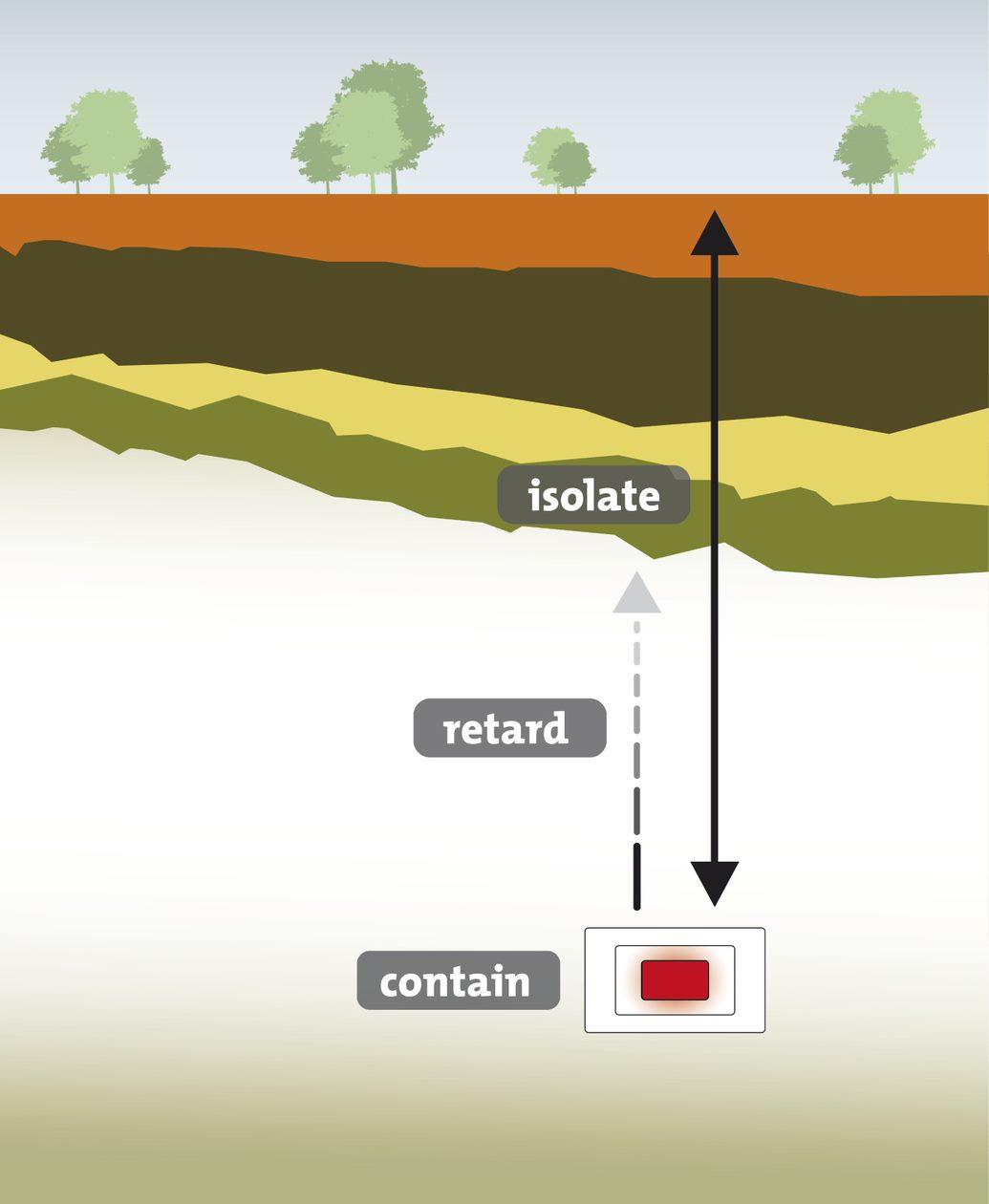Deep disposal
Principle
How does deep disposal work?
In deep (or geological) disposal, radioactive waste is placed in an underground facility surrounded by a whole series of engineered barriers, with no intention of retrieving it. The disposal facility is thus intended to be the final destination of the radioactive waste. This facility is built in a stable geological layer (the natural barrier or host rock) at a depth of several hundred metres. After its full closure, it forms a passive system requiring no further human action. Future generations, however, will have the option to supervise it.
What will assure human and environmental safety?
Three safety features (isolation, containment and retardation) ensure that humans and the environment are protected from radioactive substances. The geological layer around the facility will remain stable for hundreds of thousands of years, isolating the waste from changes on the earth's surface. The various engineered barriers around the waste will remain intact for a very long period, trapping the radioactive substances so that they cannot spread for the first few thousand years.
Once radioactive substances are nevertheless released through the engineered barriers after that period, their dispersion will be greatly retarded by the properties of the host rock acting as a natural barrier. Most of the radioactive substances will lose much of their radioactivity during this slow migration through the rock by disintegration. The small amount that eventually enters the biosphere after tens to hundreds of thousands of years will no longer be harmful to humans or the environment.

Packaging
How is radioactive waste packaged?
Besides the geological layer, the disposal facility also plays an important role for safety. Both the packaging around the radioactive waste and the installation itself contain the radioactive substances for a long period of time. The packaging also ensures that the waste can be safely placed in the disposal facility in all circumstances. Depending on the type of waste, ONDRAF/NIRAS provides two different types of packaging for disposal: monoliths and supercontainers.
Drums containing low or intermediate-level long-lived waste are placed in concrete boxes (caissons) and encapsulated with mortar. Once the mortar has hardened, it forms a monolithic block called ‘monolith’. Owing to their chemical and physical properties, concrete and mortar contain radioactive substances and limit the infiltration of water.
The drums containing the high-level short or long-lived waste are surrounded by a layer of carbon steel with a thick concrete cylinder wrapped in stainless steel around it. We refer to the entire object as a supercontainer. The steel and the concrete cylinder block the radiation, and the concrete also protects the steel from corrosion. The supercontainer thus prevents water from seeping in and coming into contact with the radioactive waste.

What happens to the disposal facility after it is filled?
The monoliths and the supercontainers are disposed of in separate underground galleries. After all the radioactive waste is placed in a gallery, it is filled with mortar and other specialised materials, just like the main galleries and access shafts. Consequently, the disposal galleries and thus the installation itself form an engineered barrier that helps contain the waste.
Underground
In which host rocks is deep disposal possible?
Worldwide, three possible categories of host rocks are suitable for deep disposal: (1) crystalline rocks such as granite, (2) evaporites such as salt and (3) clay rock. In Belgium, clay rock seems to be the most suitable for the deep disposal of radioactive waste. The Belgian underground contains, among others, poorly indurated clay rocks being the Boom clay and the Ypresian clay. Both clay formations have similar, favourable properties for deep disposal. They formed several tens of millions of years ago and are highly stable. In the southern part of the country, indurated clays are found (including in the form of schists) and may be appropriate for deep disposal.
Research carried out by ONDRAF/NIRAS for over 40 years has mainly focused on the poorly indurated clay layers in the north-eastern part of the country. Indeed, SCK CEN, the nuclear research centre located in this region, decided in the 1970s to build the underground laboratory HADES in Boom Clay on their site in Mol.
What makes poorly indurated clay in our country suitable for deep disposal?
Poorly indurated clay possesses three main properties that make the rock well adapted for deep disposal. First of all, this clay is plastic. This means that the cracks that form in it during the excavation of galleries will close by themselves after the concrete wall is in place. Moreover, clay lets hardly any water through. Finally, the clay minerals have the property of binding much of the radioactive substances to themselves so that they become trapped in the clay once they eventually escape from their engineered containment.
Are there any examples of natural "clay packing"?
There are numerous examples in nature of objects that have remained intact in clay layers for hundreds of thousands of years. Last century, for instance, trunks of primeval trees that grew during the time of the mammoths have been discovered in an Italian clay quarry. The natural 'clay packing' proved so effective that the wood even remained flammable. In Canada, meanwhile, geologists found a large billion-year-old uranium deposit about 430 metres deep in a clay layer beneath a lake. The uranium deposit remained virtually unchanged all this time thanks to the clay layer that forms a natural barrier around the ore. There is no sign of that uranium deposit on the surface of the lake, the water there meets drinking water standards.
Climate change
What is the impact of climate change on a deep disposal facility?
Today, global warming is the main topic. It could lead to a rise in sea levels that would flood part of Belgium. In such a scenario, the vulnerability of storing waste in surface buildings is obvious. Disposed of deep underground, however, it would remain isolated and confined, protected from these changes.
Researchers are also interested in longer-term climate changes, over hundreds of thousands of years, and in particular the influence of ice ages. Ice ages and warmer periods like the ones we are currently experiencing occur approximately every hundred thousand years. In our regions, an ice age mainly leads to colder temperatures and the formation of permafrost. Such cyclical phenomena significantly alter the landscape (e.g. erosion, river incision). This is why the disposal facility will be built several hundred metres below the surface so that these disturbances do not compromise its safety.
Is a deep disposal facility safe from earthquakes?
Earthquakes cause the most significant damage to the earth's surface. Moreover, earthquakes in Belgium are generally of low intensity and tend to occur in known areas. Any underground disposal facility will be built away from known seismic zones, so that the potential impact of an earthquake is minimised.
Retrievability
Can the waste be retrieved from the disposal facility?
Building the disposal facility and placing the waste in it will take decades. Although not its intention, the possibility of being able to retrieve the waste during a certain time is envisaged. The length of that period will be determined in consultation with the local community and will in any case be limited in time. After that, the facility will be completely closed to ensure safety for future generations, with no further action required. This is known as passive safety.
Effective retrieval of the waste will become increasingly difficult as the disposal facility takes its final shape. For example, it will be easier to retrieve waste before the disposal galleries are filled up. In theory, it will always be possible to retrieve the waste after the complete closure of the facility, although this will require more drastic means.
Design
How does a deep disposal facility look like?
A deep disposal facility consists of a network of horizontal galleries in which the radioactive waste is placed. These galleries are connected by main galleries accessible from the ground surface via vertical shafts. Once the disposal galleries are filled with radioactive waste, they are filled with mortar and completely closed. Next, the main galleries are also filled in and sealed, as are the access shafts.
The design of the disposal facility envisages two different zones to be built, filled with waste, backfilled and sealed in two different phases. One for low or intermediate-level long-lived waste and one for high-level waste. Because the high-level waste emits heat, the disposal galleries provided for this purpose will be further apart. In the design, these two zones together form one facility, although building two different installations is also an option.
Control measurements will take place during the entire operations for filling the disposal facility. Environmental monitoring measurements around the facility will continue to be carried out even after it is fully closed. The duration of these measurements is for future generations to decide. That said, future generations will no longer have to take any action to ensure safety. Indeed, the underground disposal facility is conceived as a passive system.

